Financial Accounting and Reporting: User Needs and Statements
VerifiedAdded on 2020/01/28
|28
|5743
|43
Report
AI Summary
This report provides a comprehensive overview of financial accounting and reporting, addressing various aspects crucial for understanding financial statements. It begins by identifying different types of users, both internal and external, and their respective information needs, emphasizing the importance of the legal and regulatory framework, including UK GAAP, IFRS, and the Companies Act 2006. The report then explores the implications of this framework for users, ensuring the reliability and relevance of financial information. Furthermore, it delves into the preparation of financial statements for diverse business structures, such as sole traders, partnerships, and limited companies, including consolidated statements. The report concludes with a detailed analysis of financial performance through ratio analysis, providing insights into the financial health of a company. The analysis of the provided case study covers profitability, liquidity, and solvency, offering valuable insights for informed decision-making. The report incorporates tables and illustrations to support the analysis, making it a comprehensive guide for students and professionals alike.

FINANCIAL ACCOUNTING
AND REPORTING
1
AND REPORTING
1
Paraphrase This Document
Need a fresh take? Get an instant paraphrase of this document with our AI Paraphraser

TABLE OF CONTENTS
INTRODUCTION ...............................................................................................................................4
TASK 1.................................................................................................................................................4
AC 1.1 Different types of users and their need................................................................................4
AC 1.2 Influence of legal and regulatory framework of financial statement..................................5
AC 1.3 Implication of legal and regulatory framework for users....................................................6
AC 1.4 Different legal and regulation dealt with accounting and reporting standards....................7
AC 3.1 Explain how information needs of different user groups vary............................................8
AC 3.2 Fundamental principles towards preparing financial statements of different organizations
.........................................................................................................................................................8
TASK 2.................................................................................................................................................9
AC 2.1 Prepare financial statements for a variety of businesses from trial balance with
adjustments......................................................................................................................................9
AC 2.2 Prepare financial statements from incomplete records.....................................................12
AC 2.3 Prepare consolidated financial statements and profit and loss account for a simple group
of companies..................................................................................................................................14
TASK 3...............................................................................................................................................16
AC 4.1 Calculation of accounting ratios........................................................................................16
AC 4.2 Prepare a report incorporating and interpreting accounting ratios with suitable
comparison.....................................................................................................................................19
CONCLUSION..................................................................................................................................20
REFERENCES...................................................................................................................................21
2
INTRODUCTION ...............................................................................................................................4
TASK 1.................................................................................................................................................4
AC 1.1 Different types of users and their need................................................................................4
AC 1.2 Influence of legal and regulatory framework of financial statement..................................5
AC 1.3 Implication of legal and regulatory framework for users....................................................6
AC 1.4 Different legal and regulation dealt with accounting and reporting standards....................7
AC 3.1 Explain how information needs of different user groups vary............................................8
AC 3.2 Fundamental principles towards preparing financial statements of different organizations
.........................................................................................................................................................8
TASK 2.................................................................................................................................................9
AC 2.1 Prepare financial statements for a variety of businesses from trial balance with
adjustments......................................................................................................................................9
AC 2.2 Prepare financial statements from incomplete records.....................................................12
AC 2.3 Prepare consolidated financial statements and profit and loss account for a simple group
of companies..................................................................................................................................14
TASK 3...............................................................................................................................................16
AC 4.1 Calculation of accounting ratios........................................................................................16
AC 4.2 Prepare a report incorporating and interpreting accounting ratios with suitable
comparison.....................................................................................................................................19
CONCLUSION..................................................................................................................................20
REFERENCES...................................................................................................................................21
2
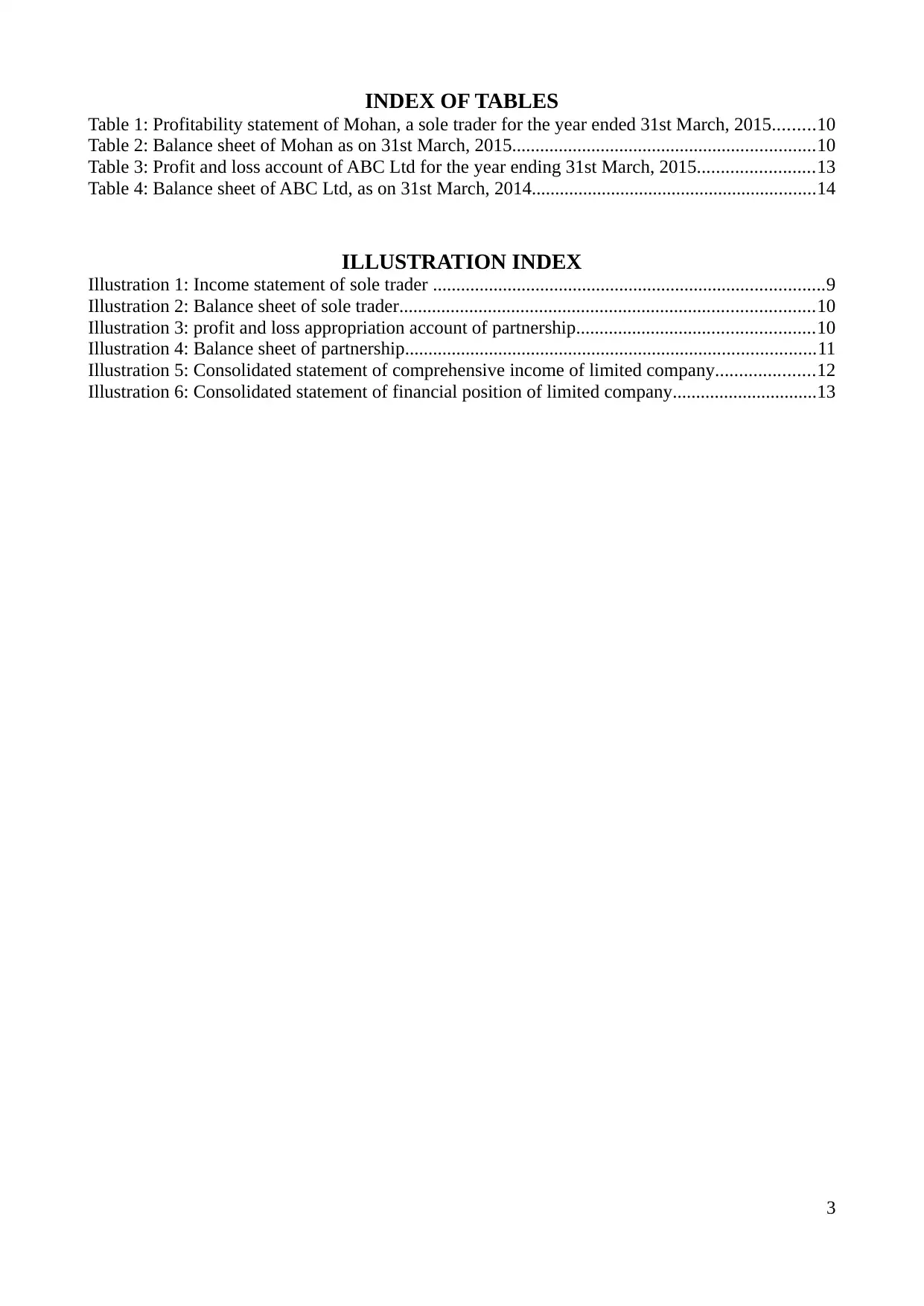
INDEX OF TABLES
Table 1: Profitability statement of Mohan, a sole trader for the year ended 31st March, 2015.........10
Table 2: Balance sheet of Mohan as on 31st March, 2015.................................................................10
Table 3: Profit and loss account of ABC Ltd for the year ending 31st March, 2015.........................13
Table 4: Balance sheet of ABC Ltd, as on 31st March, 2014.............................................................14
ILLUSTRATION INDEX
Illustration 1: Income statement of sole trader ....................................................................................9
Illustration 2: Balance sheet of sole trader.........................................................................................10
Illustration 3: profit and loss appropriation account of partnership...................................................10
Illustration 4: Balance sheet of partnership........................................................................................11
Illustration 5: Consolidated statement of comprehensive income of limited company.....................12
Illustration 6: Consolidated statement of financial position of limited company...............................13
3
Table 1: Profitability statement of Mohan, a sole trader for the year ended 31st March, 2015.........10
Table 2: Balance sheet of Mohan as on 31st March, 2015.................................................................10
Table 3: Profit and loss account of ABC Ltd for the year ending 31st March, 2015.........................13
Table 4: Balance sheet of ABC Ltd, as on 31st March, 2014.............................................................14
ILLUSTRATION INDEX
Illustration 1: Income statement of sole trader ....................................................................................9
Illustration 2: Balance sheet of sole trader.........................................................................................10
Illustration 3: profit and loss appropriation account of partnership...................................................10
Illustration 4: Balance sheet of partnership........................................................................................11
Illustration 5: Consolidated statement of comprehensive income of limited company.....................12
Illustration 6: Consolidated statement of financial position of limited company...............................13
3
⊘ This is a preview!⊘
Do you want full access?
Subscribe today to unlock all pages.

Trusted by 1+ million students worldwide
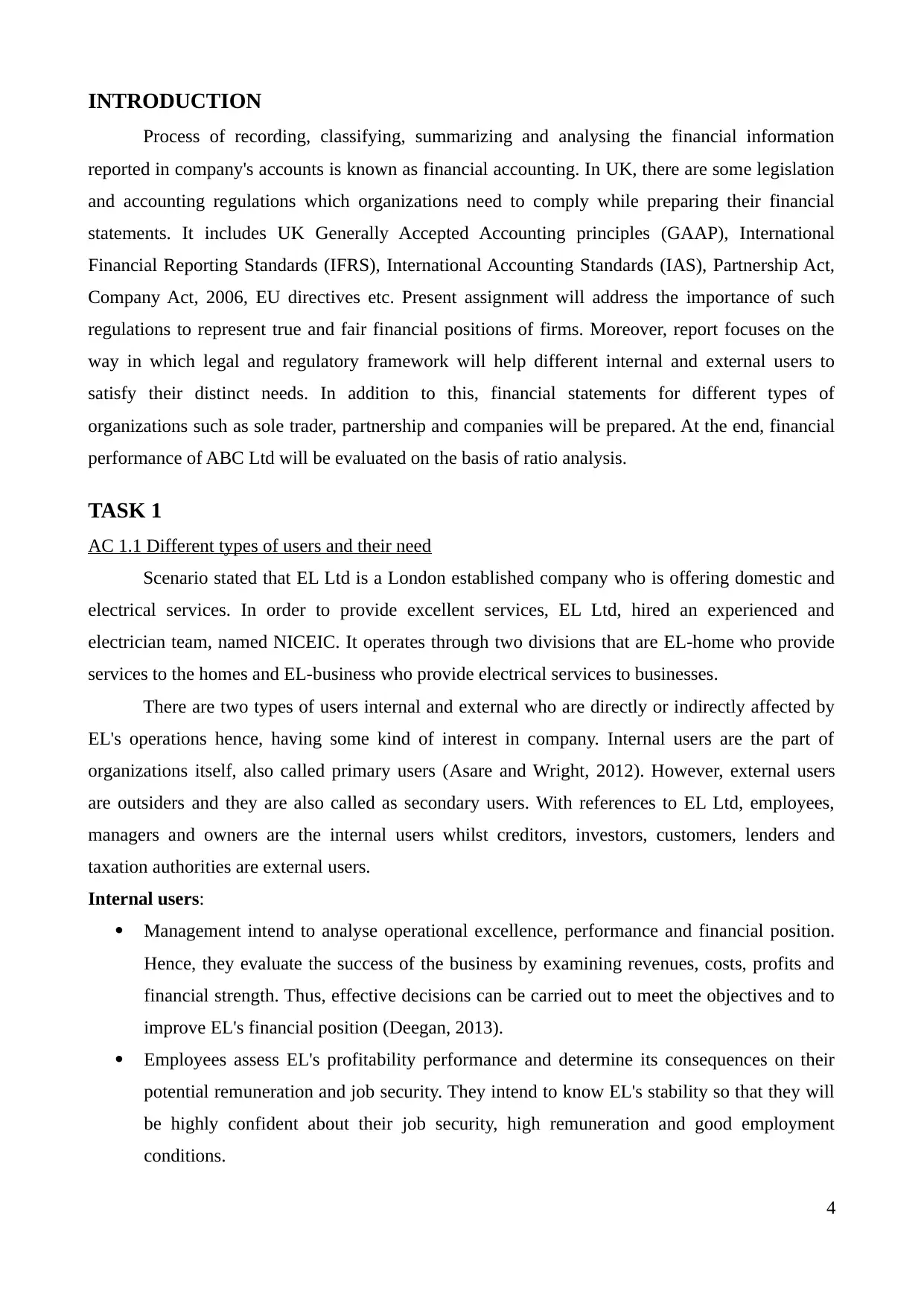
INTRODUCTION
Process of recording, classifying, summarizing and analysing the financial information
reported in company's accounts is known as financial accounting. In UK, there are some legislation
and accounting regulations which organizations need to comply while preparing their financial
statements. It includes UK Generally Accepted Accounting principles (GAAP), International
Financial Reporting Standards (IFRS), International Accounting Standards (IAS), Partnership Act,
Company Act, 2006, EU directives etc. Present assignment will address the importance of such
regulations to represent true and fair financial positions of firms. Moreover, report focuses on the
way in which legal and regulatory framework will help different internal and external users to
satisfy their distinct needs. In addition to this, financial statements for different types of
organizations such as sole trader, partnership and companies will be prepared. At the end, financial
performance of ABC Ltd will be evaluated on the basis of ratio analysis.
TASK 1
AC 1.1 Different types of users and their need
Scenario stated that EL Ltd is a London established company who is offering domestic and
electrical services. In order to provide excellent services, EL Ltd, hired an experienced and
electrician team, named NICEIC. It operates through two divisions that are EL-home who provide
services to the homes and EL-business who provide electrical services to businesses.
There are two types of users internal and external who are directly or indirectly affected by
EL's operations hence, having some kind of interest in company. Internal users are the part of
organizations itself, also called primary users (Asare and Wright, 2012). However, external users
are outsiders and they are also called as secondary users. With references to EL Ltd, employees,
managers and owners are the internal users whilst creditors, investors, customers, lenders and
taxation authorities are external users.
Internal users:
Management intend to analyse operational excellence, performance and financial position.
Hence, they evaluate the success of the business by examining revenues, costs, profits and
financial strength. Thus, effective decisions can be carried out to meet the objectives and to
improve EL's financial position (Deegan, 2013).
Employees assess EL's profitability performance and determine its consequences on their
potential remuneration and job security. They intend to know EL's stability so that they will
be highly confident about their job security, high remuneration and good employment
conditions.
4
Process of recording, classifying, summarizing and analysing the financial information
reported in company's accounts is known as financial accounting. In UK, there are some legislation
and accounting regulations which organizations need to comply while preparing their financial
statements. It includes UK Generally Accepted Accounting principles (GAAP), International
Financial Reporting Standards (IFRS), International Accounting Standards (IAS), Partnership Act,
Company Act, 2006, EU directives etc. Present assignment will address the importance of such
regulations to represent true and fair financial positions of firms. Moreover, report focuses on the
way in which legal and regulatory framework will help different internal and external users to
satisfy their distinct needs. In addition to this, financial statements for different types of
organizations such as sole trader, partnership and companies will be prepared. At the end, financial
performance of ABC Ltd will be evaluated on the basis of ratio analysis.
TASK 1
AC 1.1 Different types of users and their need
Scenario stated that EL Ltd is a London established company who is offering domestic and
electrical services. In order to provide excellent services, EL Ltd, hired an experienced and
electrician team, named NICEIC. It operates through two divisions that are EL-home who provide
services to the homes and EL-business who provide electrical services to businesses.
There are two types of users internal and external who are directly or indirectly affected by
EL's operations hence, having some kind of interest in company. Internal users are the part of
organizations itself, also called primary users (Asare and Wright, 2012). However, external users
are outsiders and they are also called as secondary users. With references to EL Ltd, employees,
managers and owners are the internal users whilst creditors, investors, customers, lenders and
taxation authorities are external users.
Internal users:
Management intend to analyse operational excellence, performance and financial position.
Hence, they evaluate the success of the business by examining revenues, costs, profits and
financial strength. Thus, effective decisions can be carried out to meet the objectives and to
improve EL's financial position (Deegan, 2013).
Employees assess EL's profitability performance and determine its consequences on their
potential remuneration and job security. They intend to know EL's stability so that they will
be highly confident about their job security, high remuneration and good employment
conditions.
4
Paraphrase This Document
Need a fresh take? Get an instant paraphrase of this document with our AI Paraphraser
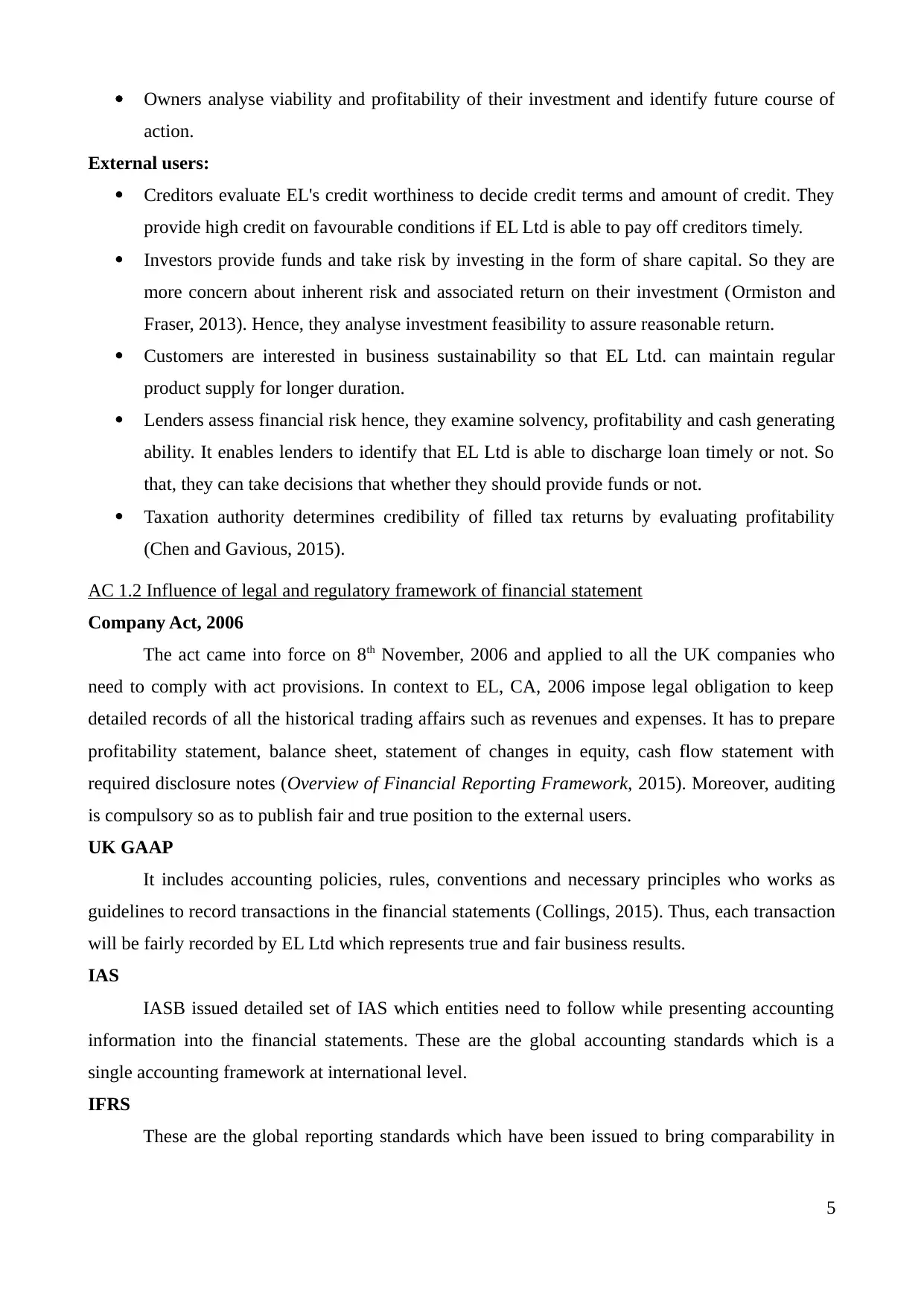
Owners analyse viability and profitability of their investment and identify future course of
action.
External users:
Creditors evaluate EL's credit worthiness to decide credit terms and amount of credit. They
provide high credit on favourable conditions if EL Ltd is able to pay off creditors timely.
Investors provide funds and take risk by investing in the form of share capital. So they are
more concern about inherent risk and associated return on their investment (Ormiston and
Fraser, 2013). Hence, they analyse investment feasibility to assure reasonable return.
Customers are interested in business sustainability so that EL Ltd. can maintain regular
product supply for longer duration.
Lenders assess financial risk hence, they examine solvency, profitability and cash generating
ability. It enables lenders to identify that EL Ltd is able to discharge loan timely or not. So
that, they can take decisions that whether they should provide funds or not.
Taxation authority determines credibility of filled tax returns by evaluating profitability
(Chen and Gavious, 2015).
AC 1.2 Influence of legal and regulatory framework of financial statement
Company Act, 2006
The act came into force on 8th November, 2006 and applied to all the UK companies who
need to comply with act provisions. In context to EL, CA, 2006 impose legal obligation to keep
detailed records of all the historical trading affairs such as revenues and expenses. It has to prepare
profitability statement, balance sheet, statement of changes in equity, cash flow statement with
required disclosure notes (Overview of Financial Reporting Framework, 2015). Moreover, auditing
is compulsory so as to publish fair and true position to the external users.
UK GAAP
It includes accounting policies, rules, conventions and necessary principles who works as
guidelines to record transactions in the financial statements (Collings, 2015). Thus, each transaction
will be fairly recorded by EL Ltd which represents true and fair business results.
IAS
IASB issued detailed set of IAS which entities need to follow while presenting accounting
information into the financial statements. These are the global accounting standards which is a
single accounting framework at international level.
IFRS
These are the global reporting standards which have been issued to bring comparability in
5
action.
External users:
Creditors evaluate EL's credit worthiness to decide credit terms and amount of credit. They
provide high credit on favourable conditions if EL Ltd is able to pay off creditors timely.
Investors provide funds and take risk by investing in the form of share capital. So they are
more concern about inherent risk and associated return on their investment (Ormiston and
Fraser, 2013). Hence, they analyse investment feasibility to assure reasonable return.
Customers are interested in business sustainability so that EL Ltd. can maintain regular
product supply for longer duration.
Lenders assess financial risk hence, they examine solvency, profitability and cash generating
ability. It enables lenders to identify that EL Ltd is able to discharge loan timely or not. So
that, they can take decisions that whether they should provide funds or not.
Taxation authority determines credibility of filled tax returns by evaluating profitability
(Chen and Gavious, 2015).
AC 1.2 Influence of legal and regulatory framework of financial statement
Company Act, 2006
The act came into force on 8th November, 2006 and applied to all the UK companies who
need to comply with act provisions. In context to EL, CA, 2006 impose legal obligation to keep
detailed records of all the historical trading affairs such as revenues and expenses. It has to prepare
profitability statement, balance sheet, statement of changes in equity, cash flow statement with
required disclosure notes (Overview of Financial Reporting Framework, 2015). Moreover, auditing
is compulsory so as to publish fair and true position to the external users.
UK GAAP
It includes accounting policies, rules, conventions and necessary principles who works as
guidelines to record transactions in the financial statements (Collings, 2015). Thus, each transaction
will be fairly recorded by EL Ltd which represents true and fair business results.
IAS
IASB issued detailed set of IAS which entities need to follow while presenting accounting
information into the financial statements. These are the global accounting standards which is a
single accounting framework at international level.
IFRS
These are the global reporting standards which have been issued to bring comparability in
5
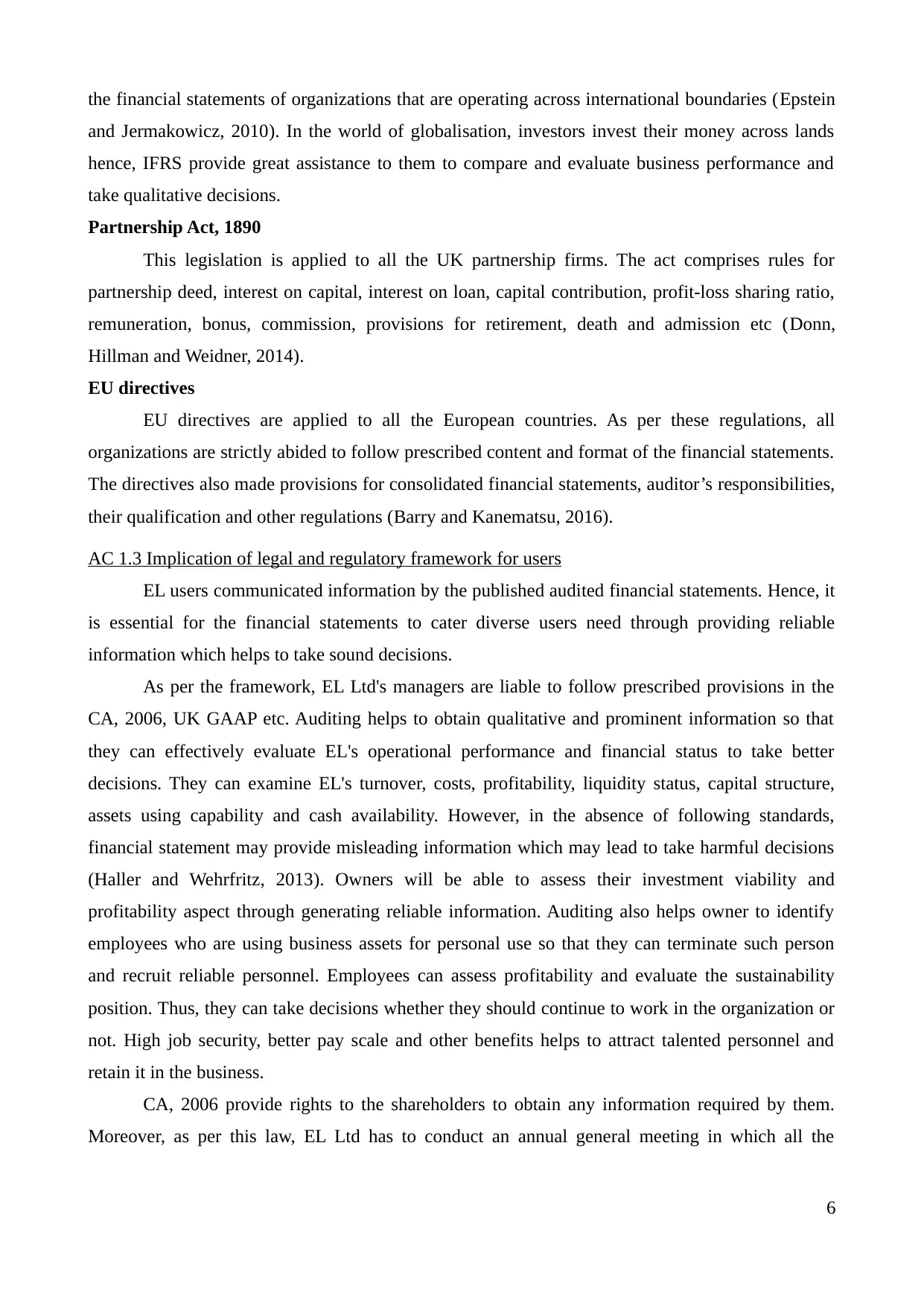
the financial statements of organizations that are operating across international boundaries (Epstein
and Jermakowicz, 2010). In the world of globalisation, investors invest their money across lands
hence, IFRS provide great assistance to them to compare and evaluate business performance and
take qualitative decisions.
Partnership Act, 1890
This legislation is applied to all the UK partnership firms. The act comprises rules for
partnership deed, interest on capital, interest on loan, capital contribution, profit-loss sharing ratio,
remuneration, bonus, commission, provisions for retirement, death and admission etc (Donn,
Hillman and Weidner, 2014).
EU directives
EU directives are applied to all the European countries. As per these regulations, all
organizations are strictly abided to follow prescribed content and format of the financial statements.
The directives also made provisions for consolidated financial statements, auditor’s responsibilities,
their qualification and other regulations (Barry and Kanematsu, 2016).
AC 1.3 Implication of legal and regulatory framework for users
EL users communicated information by the published audited financial statements. Hence, it
is essential for the financial statements to cater diverse users need through providing reliable
information which helps to take sound decisions.
As per the framework, EL Ltd's managers are liable to follow prescribed provisions in the
CA, 2006, UK GAAP etc. Auditing helps to obtain qualitative and prominent information so that
they can effectively evaluate EL's operational performance and financial status to take better
decisions. They can examine EL's turnover, costs, profitability, liquidity status, capital structure,
assets using capability and cash availability. However, in the absence of following standards,
financial statement may provide misleading information which may lead to take harmful decisions
(Haller and Wehrfritz, 2013). Owners will be able to assess their investment viability and
profitability aspect through generating reliable information. Auditing also helps owner to identify
employees who are using business assets for personal use so that they can terminate such person
and recruit reliable personnel. Employees can assess profitability and evaluate the sustainability
position. Thus, they can take decisions whether they should continue to work in the organization or
not. High job security, better pay scale and other benefits helps to attract talented personnel and
retain it in the business.
CA, 2006 provide rights to the shareholders to obtain any information required by them.
Moreover, as per this law, EL Ltd has to conduct an annual general meeting in which all the
6
and Jermakowicz, 2010). In the world of globalisation, investors invest their money across lands
hence, IFRS provide great assistance to them to compare and evaluate business performance and
take qualitative decisions.
Partnership Act, 1890
This legislation is applied to all the UK partnership firms. The act comprises rules for
partnership deed, interest on capital, interest on loan, capital contribution, profit-loss sharing ratio,
remuneration, bonus, commission, provisions for retirement, death and admission etc (Donn,
Hillman and Weidner, 2014).
EU directives
EU directives are applied to all the European countries. As per these regulations, all
organizations are strictly abided to follow prescribed content and format of the financial statements.
The directives also made provisions for consolidated financial statements, auditor’s responsibilities,
their qualification and other regulations (Barry and Kanematsu, 2016).
AC 1.3 Implication of legal and regulatory framework for users
EL users communicated information by the published audited financial statements. Hence, it
is essential for the financial statements to cater diverse users need through providing reliable
information which helps to take sound decisions.
As per the framework, EL Ltd's managers are liable to follow prescribed provisions in the
CA, 2006, UK GAAP etc. Auditing helps to obtain qualitative and prominent information so that
they can effectively evaluate EL's operational performance and financial status to take better
decisions. They can examine EL's turnover, costs, profitability, liquidity status, capital structure,
assets using capability and cash availability. However, in the absence of following standards,
financial statement may provide misleading information which may lead to take harmful decisions
(Haller and Wehrfritz, 2013). Owners will be able to assess their investment viability and
profitability aspect through generating reliable information. Auditing also helps owner to identify
employees who are using business assets for personal use so that they can terminate such person
and recruit reliable personnel. Employees can assess profitability and evaluate the sustainability
position. Thus, they can take decisions whether they should continue to work in the organization or
not. High job security, better pay scale and other benefits helps to attract talented personnel and
retain it in the business.
CA, 2006 provide rights to the shareholders to obtain any information required by them.
Moreover, as per this law, EL Ltd has to conduct an annual general meeting in which all the
6
⊘ This is a preview!⊘
Do you want full access?
Subscribe today to unlock all pages.

Trusted by 1+ million students worldwide
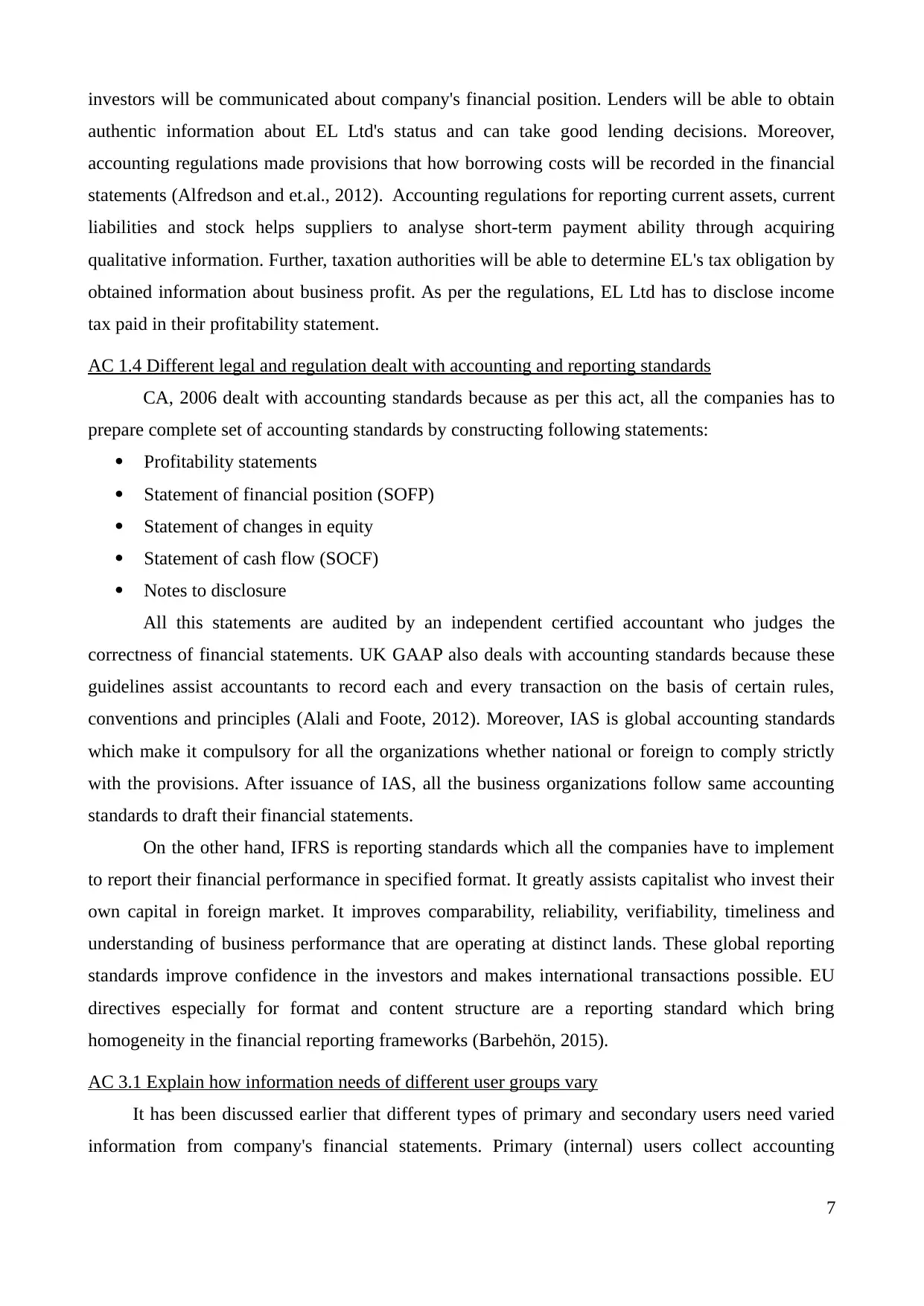
investors will be communicated about company's financial position. Lenders will be able to obtain
authentic information about EL Ltd's status and can take good lending decisions. Moreover,
accounting regulations made provisions that how borrowing costs will be recorded in the financial
statements (Alfredson and et.al., 2012). Accounting regulations for reporting current assets, current
liabilities and stock helps suppliers to analyse short-term payment ability through acquiring
qualitative information. Further, taxation authorities will be able to determine EL's tax obligation by
obtained information about business profit. As per the regulations, EL Ltd has to disclose income
tax paid in their profitability statement.
AC 1.4 Different legal and regulation dealt with accounting and reporting standards
CA, 2006 dealt with accounting standards because as per this act, all the companies has to
prepare complete set of accounting standards by constructing following statements:
Profitability statements
Statement of financial position (SOFP)
Statement of changes in equity
Statement of cash flow (SOCF)
Notes to disclosure
All this statements are audited by an independent certified accountant who judges the
correctness of financial statements. UK GAAP also deals with accounting standards because these
guidelines assist accountants to record each and every transaction on the basis of certain rules,
conventions and principles (Alali and Foote, 2012). Moreover, IAS is global accounting standards
which make it compulsory for all the organizations whether national or foreign to comply strictly
with the provisions. After issuance of IAS, all the business organizations follow same accounting
standards to draft their financial statements.
On the other hand, IFRS is reporting standards which all the companies have to implement
to report their financial performance in specified format. It greatly assists capitalist who invest their
own capital in foreign market. It improves comparability, reliability, verifiability, timeliness and
understanding of business performance that are operating at distinct lands. These global reporting
standards improve confidence in the investors and makes international transactions possible. EU
directives especially for format and content structure are a reporting standard which bring
homogeneity in the financial reporting frameworks (Barbehön, 2015).
AC 3.1 Explain how information needs of different user groups vary
It has been discussed earlier that different types of primary and secondary users need varied
information from company's financial statements. Primary (internal) users collect accounting
7
authentic information about EL Ltd's status and can take good lending decisions. Moreover,
accounting regulations made provisions that how borrowing costs will be recorded in the financial
statements (Alfredson and et.al., 2012). Accounting regulations for reporting current assets, current
liabilities and stock helps suppliers to analyse short-term payment ability through acquiring
qualitative information. Further, taxation authorities will be able to determine EL's tax obligation by
obtained information about business profit. As per the regulations, EL Ltd has to disclose income
tax paid in their profitability statement.
AC 1.4 Different legal and regulation dealt with accounting and reporting standards
CA, 2006 dealt with accounting standards because as per this act, all the companies has to
prepare complete set of accounting standards by constructing following statements:
Profitability statements
Statement of financial position (SOFP)
Statement of changes in equity
Statement of cash flow (SOCF)
Notes to disclosure
All this statements are audited by an independent certified accountant who judges the
correctness of financial statements. UK GAAP also deals with accounting standards because these
guidelines assist accountants to record each and every transaction on the basis of certain rules,
conventions and principles (Alali and Foote, 2012). Moreover, IAS is global accounting standards
which make it compulsory for all the organizations whether national or foreign to comply strictly
with the provisions. After issuance of IAS, all the business organizations follow same accounting
standards to draft their financial statements.
On the other hand, IFRS is reporting standards which all the companies have to implement
to report their financial performance in specified format. It greatly assists capitalist who invest their
own capital in foreign market. It improves comparability, reliability, verifiability, timeliness and
understanding of business performance that are operating at distinct lands. These global reporting
standards improve confidence in the investors and makes international transactions possible. EU
directives especially for format and content structure are a reporting standard which bring
homogeneity in the financial reporting frameworks (Barbehön, 2015).
AC 3.1 Explain how information needs of different user groups vary
It has been discussed earlier that different types of primary and secondary users need varied
information from company's financial statements. Primary (internal) users collect accounting
7
Paraphrase This Document
Need a fresh take? Get an instant paraphrase of this document with our AI Paraphraser
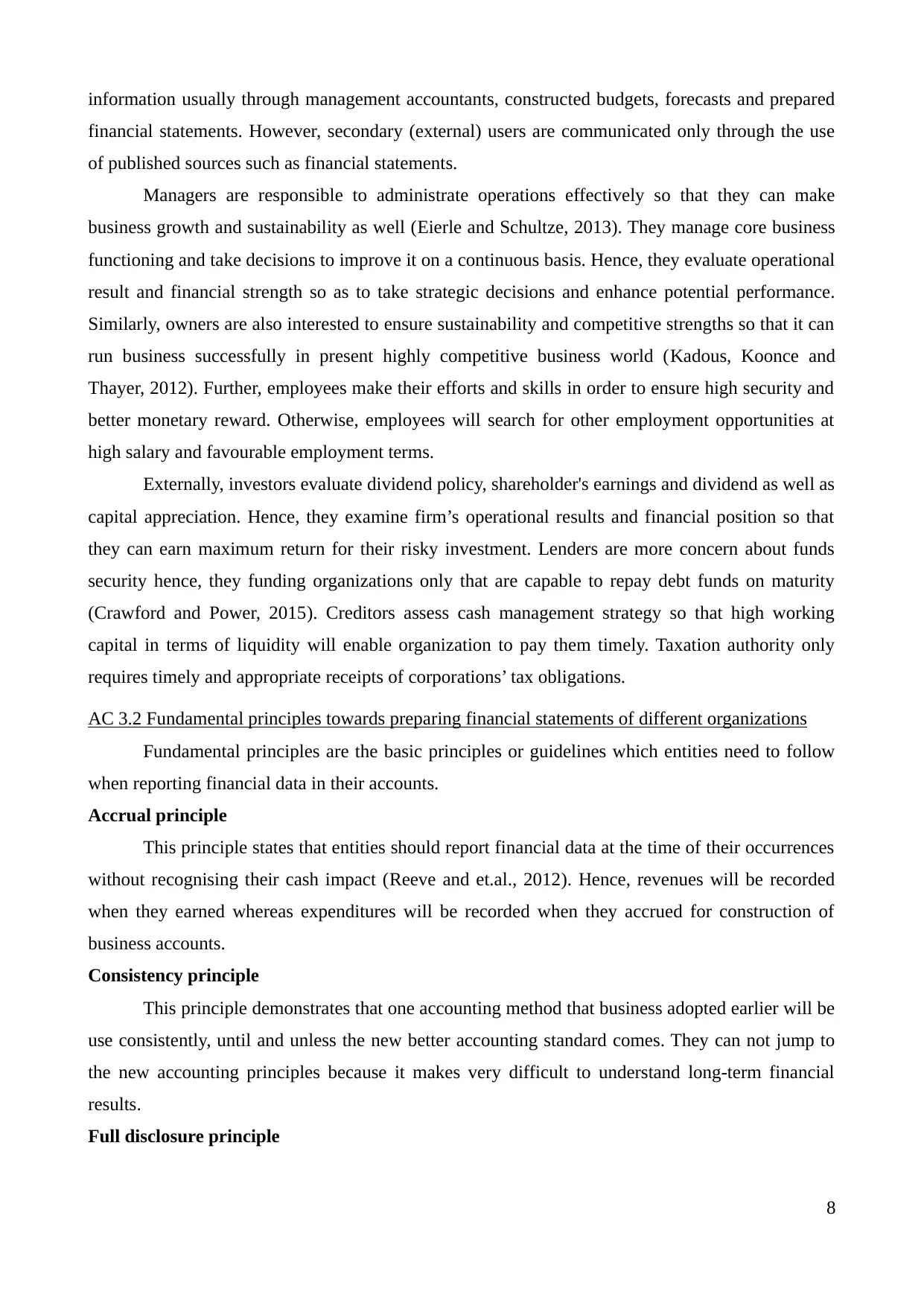
information usually through management accountants, constructed budgets, forecasts and prepared
financial statements. However, secondary (external) users are communicated only through the use
of published sources such as financial statements.
Managers are responsible to administrate operations effectively so that they can make
business growth and sustainability as well (Eierle and Schultze, 2013). They manage core business
functioning and take decisions to improve it on a continuous basis. Hence, they evaluate operational
result and financial strength so as to take strategic decisions and enhance potential performance.
Similarly, owners are also interested to ensure sustainability and competitive strengths so that it can
run business successfully in present highly competitive business world (Kadous, Koonce and
Thayer, 2012). Further, employees make their efforts and skills in order to ensure high security and
better monetary reward. Otherwise, employees will search for other employment opportunities at
high salary and favourable employment terms.
Externally, investors evaluate dividend policy, shareholder's earnings and dividend as well as
capital appreciation. Hence, they examine firm’s operational results and financial position so that
they can earn maximum return for their risky investment. Lenders are more concern about funds
security hence, they funding organizations only that are capable to repay debt funds on maturity
(Crawford and Power, 2015). Creditors assess cash management strategy so that high working
capital in terms of liquidity will enable organization to pay them timely. Taxation authority only
requires timely and appropriate receipts of corporations’ tax obligations.
AC 3.2 Fundamental principles towards preparing financial statements of different organizations
Fundamental principles are the basic principles or guidelines which entities need to follow
when reporting financial data in their accounts.
Accrual principle
This principle states that entities should report financial data at the time of their occurrences
without recognising their cash impact (Reeve and et.al., 2012). Hence, revenues will be recorded
when they earned whereas expenditures will be recorded when they accrued for construction of
business accounts.
Consistency principle
This principle demonstrates that one accounting method that business adopted earlier will be
use consistently, until and unless the new better accounting standard comes. They can not jump to
the new accounting principles because it makes very difficult to understand long-term financial
results.
Full disclosure principle
8
financial statements. However, secondary (external) users are communicated only through the use
of published sources such as financial statements.
Managers are responsible to administrate operations effectively so that they can make
business growth and sustainability as well (Eierle and Schultze, 2013). They manage core business
functioning and take decisions to improve it on a continuous basis. Hence, they evaluate operational
result and financial strength so as to take strategic decisions and enhance potential performance.
Similarly, owners are also interested to ensure sustainability and competitive strengths so that it can
run business successfully in present highly competitive business world (Kadous, Koonce and
Thayer, 2012). Further, employees make their efforts and skills in order to ensure high security and
better monetary reward. Otherwise, employees will search for other employment opportunities at
high salary and favourable employment terms.
Externally, investors evaluate dividend policy, shareholder's earnings and dividend as well as
capital appreciation. Hence, they examine firm’s operational results and financial position so that
they can earn maximum return for their risky investment. Lenders are more concern about funds
security hence, they funding organizations only that are capable to repay debt funds on maturity
(Crawford and Power, 2015). Creditors assess cash management strategy so that high working
capital in terms of liquidity will enable organization to pay them timely. Taxation authority only
requires timely and appropriate receipts of corporations’ tax obligations.
AC 3.2 Fundamental principles towards preparing financial statements of different organizations
Fundamental principles are the basic principles or guidelines which entities need to follow
when reporting financial data in their accounts.
Accrual principle
This principle states that entities should report financial data at the time of their occurrences
without recognising their cash impact (Reeve and et.al., 2012). Hence, revenues will be recorded
when they earned whereas expenditures will be recorded when they accrued for construction of
business accounts.
Consistency principle
This principle demonstrates that one accounting method that business adopted earlier will be
use consistently, until and unless the new better accounting standard comes. They can not jump to
the new accounting principles because it makes very difficult to understand long-term financial
results.
Full disclosure principle
8
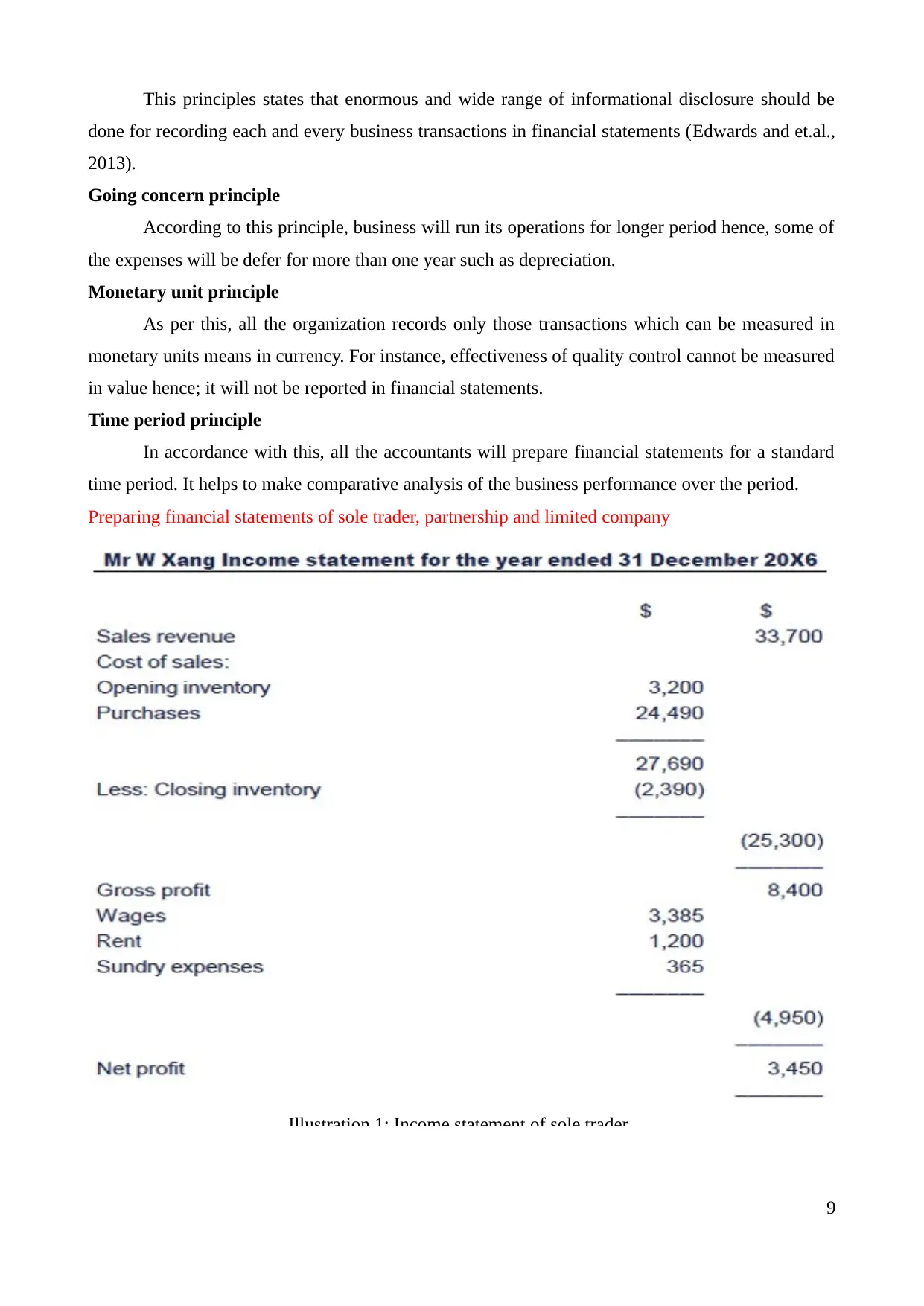
This principles states that enormous and wide range of informational disclosure should be
done for recording each and every business transactions in financial statements (Edwards and et.al.,
2013).
Going concern principle
According to this principle, business will run its operations for longer period hence, some of
the expenses will be defer for more than one year such as depreciation.
Monetary unit principle
As per this, all the organization records only those transactions which can be measured in
monetary units means in currency. For instance, effectiveness of quality control cannot be measured
in value hence; it will not be reported in financial statements.
Time period principle
In accordance with this, all the accountants will prepare financial statements for a standard
time period. It helps to make comparative analysis of the business performance over the period.
Preparing financial statements of sole trader, partnership and limited company
Illustration 1: Income statement of sole trader
9
done for recording each and every business transactions in financial statements (Edwards and et.al.,
2013).
Going concern principle
According to this principle, business will run its operations for longer period hence, some of
the expenses will be defer for more than one year such as depreciation.
Monetary unit principle
As per this, all the organization records only those transactions which can be measured in
monetary units means in currency. For instance, effectiveness of quality control cannot be measured
in value hence; it will not be reported in financial statements.
Time period principle
In accordance with this, all the accountants will prepare financial statements for a standard
time period. It helps to make comparative analysis of the business performance over the period.
Preparing financial statements of sole trader, partnership and limited company
Illustration 1: Income statement of sole trader
9
⊘ This is a preview!⊘
Do you want full access?
Subscribe today to unlock all pages.

Trusted by 1+ million students worldwide
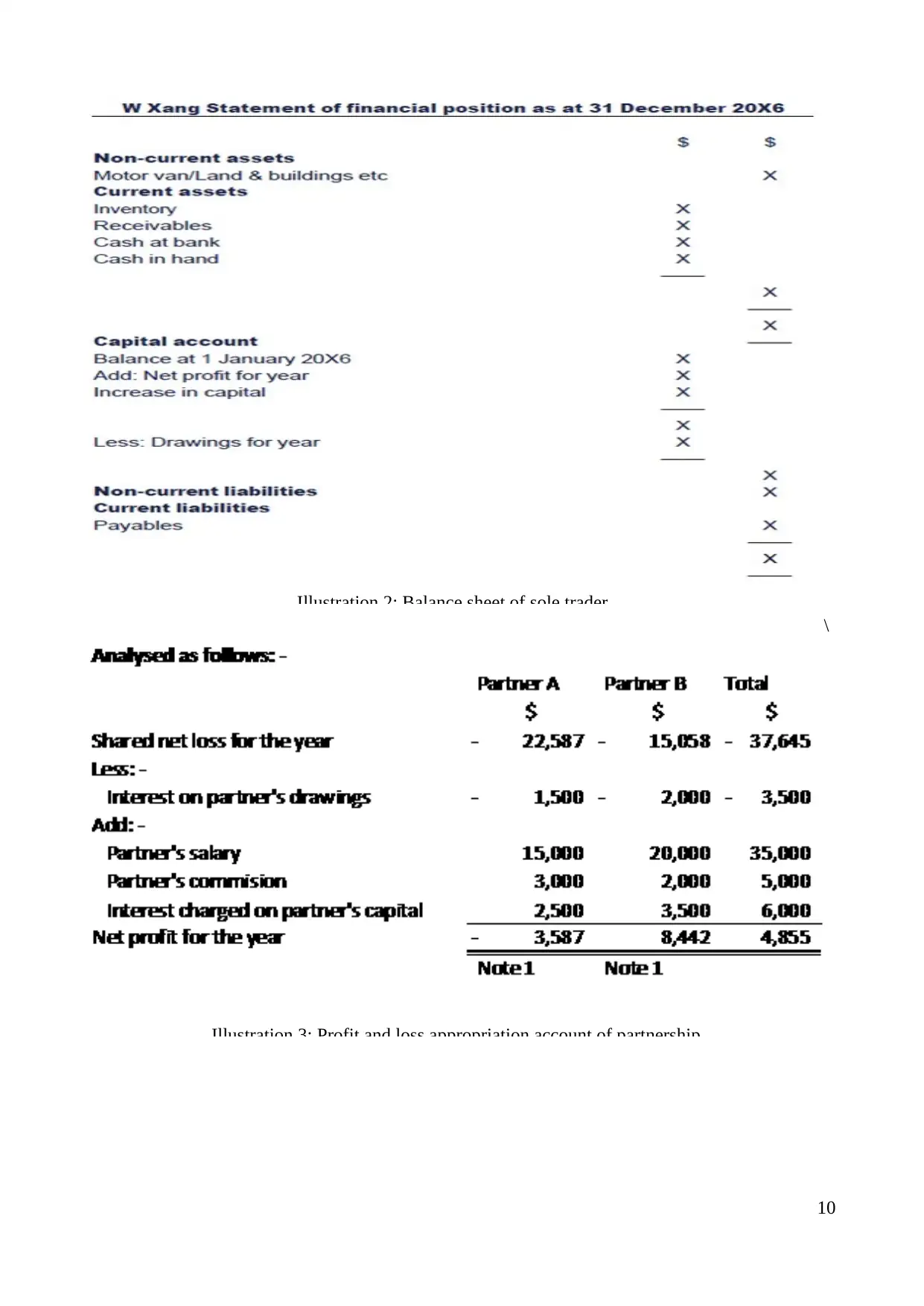
Illustration 2: Balance sheet of sole trader
Illustration 3: Profit and loss appropriation account of partnership
\
10
Illustration 3: Profit and loss appropriation account of partnership
\
10
Paraphrase This Document
Need a fresh take? Get an instant paraphrase of this document with our AI Paraphraser
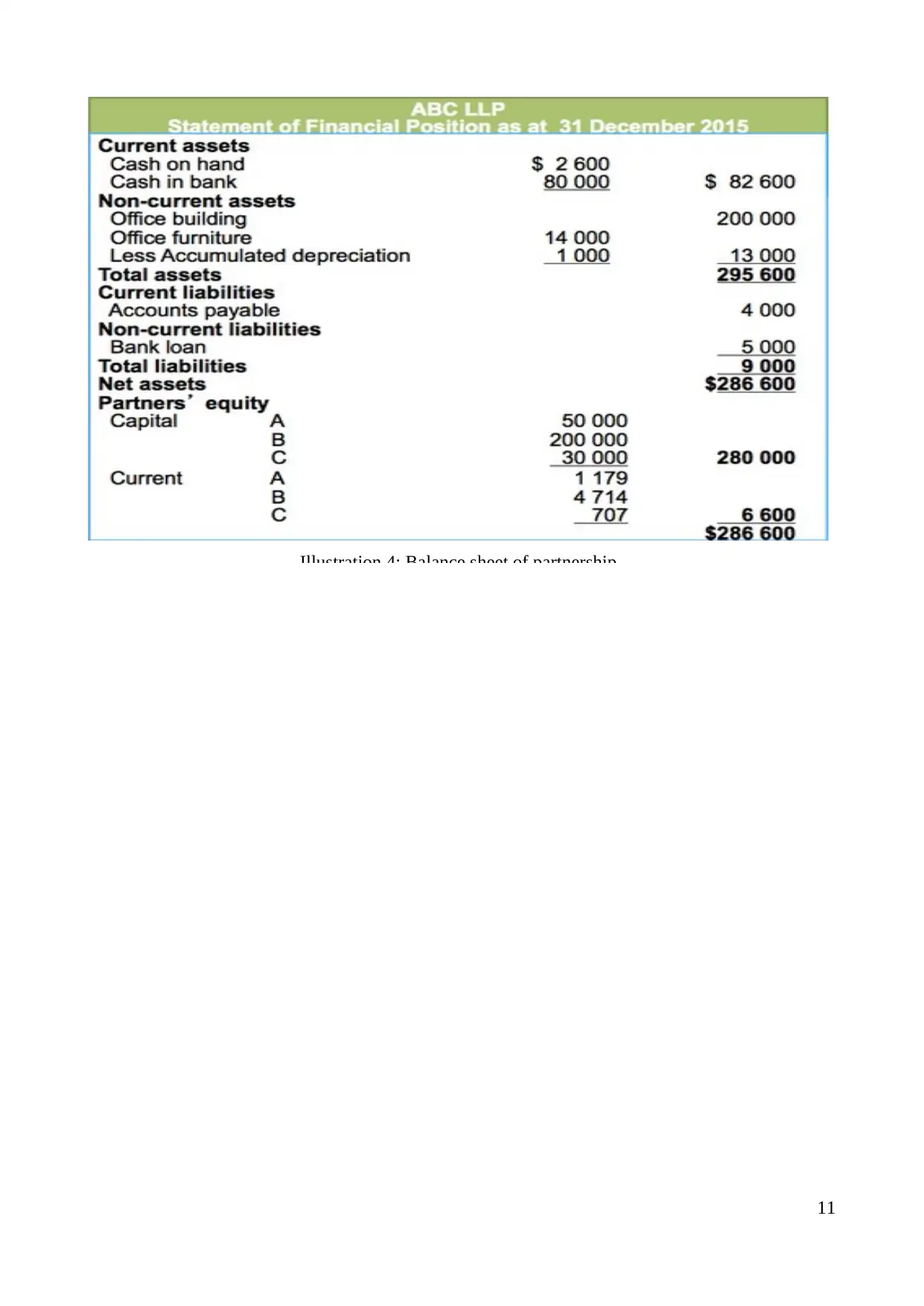
Illustration 4: Balance sheet of partnership
11
11
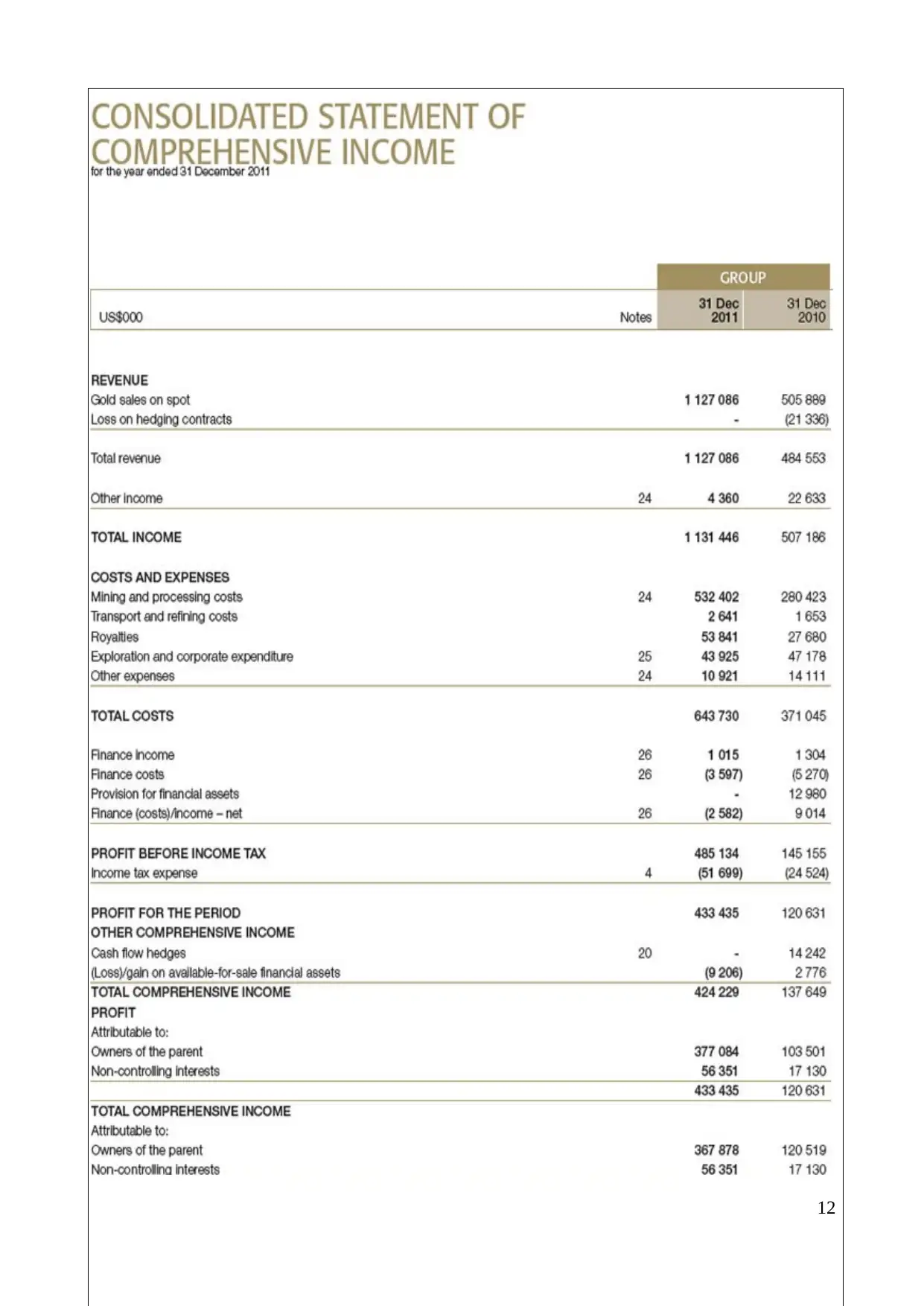
12
⊘ This is a preview!⊘
Do you want full access?
Subscribe today to unlock all pages.

Trusted by 1+ million students worldwide
1 out of 28
Related Documents
Your All-in-One AI-Powered Toolkit for Academic Success.
+13062052269
info@desklib.com
Available 24*7 on WhatsApp / Email
![[object Object]](/_next/static/media/star-bottom.7253800d.svg)
Unlock your academic potential
Copyright © 2020–2025 A2Z Services. All Rights Reserved. Developed and managed by ZUCOL.





